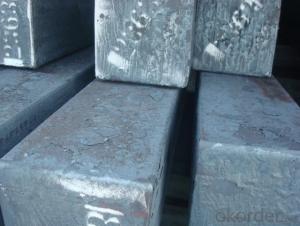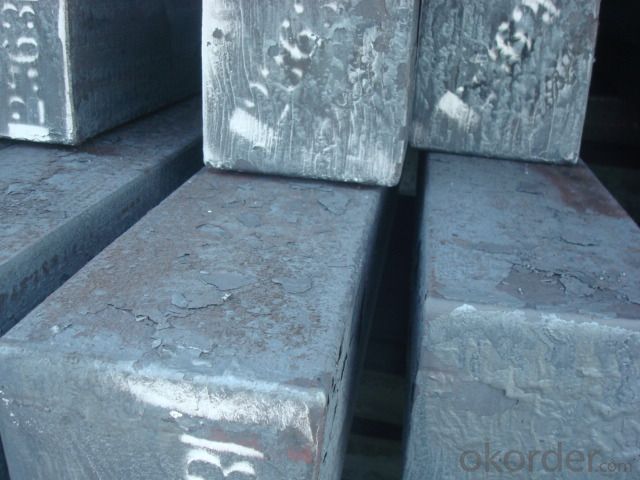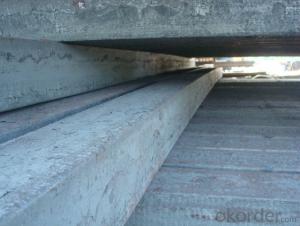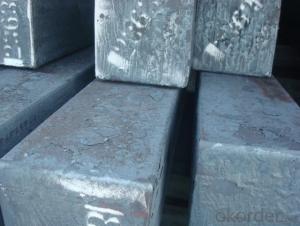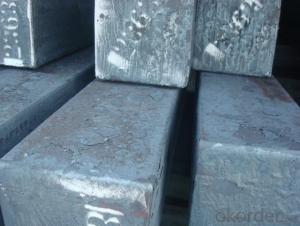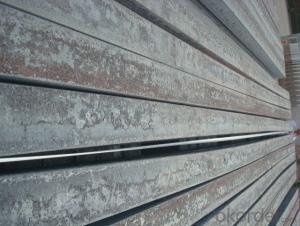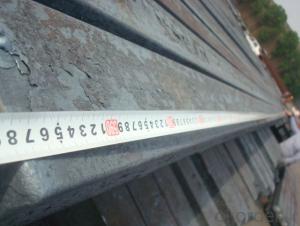Continue Casting Steel Billet by Blast Furnace
- Loading Port:
- Tianjin
- Payment Terms:
- TT OR LC
- Min Order Qty:
- 25 m.t.
- Supply Capability:
- 10000 m.t./month
OKorder Service Pledge
OKorder Financial Service
You Might Also Like
Continue Casting Steel Billet by Blast Furnace
1.Structure of Continue Casting Steel Billet by Blast Furnace
Continue casting steel billet by blast furnace is the raw material of all kinds of steel mill. Billet section of square, round, flat, rectangular and abnormity, etc Several, mainly related to shape of rolled products. Simple rolled section steel, choose cross section of square billet or rectangular billet. rolling The sector products such as flat steel, Angle steel, select the rectangular billet or slab. Had better profiled billet when production beams, channels, and in rolling process Lines and improve the yield. The raw material of round billet is the production of seamless tube.
2.Main Features of Continue Casting Steel Billet by Blast Furnace.
Continue Casting Steel Billet by Blast Furnace section size should meet the requirements of rolling deformation and finished product quality, but also roll strength and biting condition of restrictions. General steel Billet section height H. And the roll diameter D The ratio of the ( namely H/D) Should be less than or equal to zero 0.5 . Length of steel billet by finishing temperature, Rolling time and the length of the product Or times ruler. When heated too long accident prone to bump the furnace wall of steel, too short, furnace bottom utilization rate is not high, influence the heating furnace production. For the production Choose a variety of steel and steel billet, should consider the affinities of billet, as far as possible in order to improve the productivity of the roughing mill, simplify the stock management of workshop.
3. Continue Casting Steel Billet by Blast Furnace Images
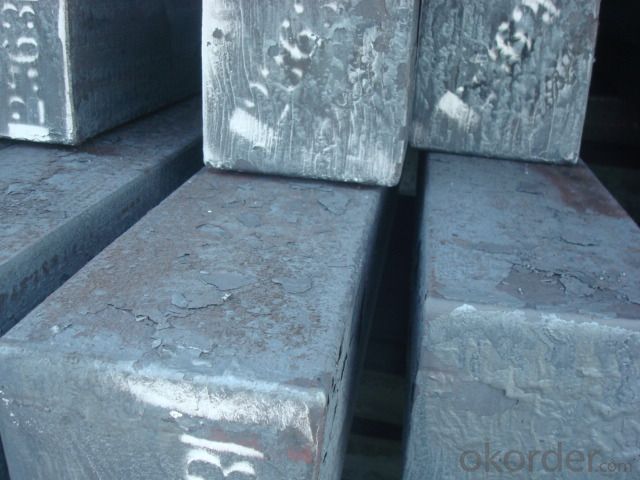

4. Continue Casting Steel Billet by Blast Furnace Specification
Continue Casting Steel Billet by Blast Furnace rolled steel, after processing can be used for mechanical parts, forging parts, processing all kinds of steel, steel Q345B channel steel, wire rod is the role of the billet. Steel billet is used in the production of semi-finished products, generally cannot be used directly for the society. Steel billets and steel are strictly divided into standard, cannot decide to whether the business enterprise of the final product, and according to unified standards to perform the whole society. Typically, billet and the steel is relatively easy to distinguish, but for some steel billet, and have the same specification and same steel purposes (such as rolling tube billet), whether can be used for other industries, whether through steel processing process, whether through a finished product rolling mill processing to distinguish
Material standard The editor Range of thickness: 150-240 - mm + / - 5 mm width range: 880-1530 - mm + / - 20 mm Length: 3700-10000 - mm + / - 500 - mm Cross-sectional size: 64 * 64; 82 * 82; 98 * 98; 124 * 124; 120 * 150; 152 * 164; 152 * 170 mm Length: 9000 mm Section of tolerance: billet: 1.0 + / - 2.0-1.0 + / - 1.0 mm slab: width: + / - 2.0 mm thickness: + / - 3.0 mm The length tolerance: + / - 200 mm Section diagonal tolerance: 3.5-8.0 MM Billet section size protrusions requirements: < 1242 mm, do not allow; > = 1242 mm, < = 2 mm 1242 mm, < = 3 mm Beheading (shear) extension deformation: < 1242 mm billet: no control; The slab: < = 15 mm Surface tilt: no more than billet section 0.1 Bending: every 1 m length is not more than 10 mm The distortion: length < = 5 m, < = 11. ; The length of the < = 7.5 M, < = 5. Material % 3 sp/PS chemical composition: C Mn Si S P
5.FAQ of Continue Casting Steel Billet by Blast Furnace
We have organized several common questions for our clients,may help you sincerely:
①How about your company?
A world class manufacturer & supplier of castings forging in carbon steel and alloy steel,is one of the large-scale professional investment casting production bases in China,consisting of both casting foundry forging and machining factory. Annually more than 8000 tons Precision casting and forging parts are exported to markets in Europe,America and Japan. OEM casting and forging service available according to customer’s requirements.
②How to guarantee the quality of the products?
We have established the international advanced quality management system,every link from raw material to final product we have strict quality test;We resolutely put an end to unqualified products flowing into the market. At the same time, we will provide necessary follow-up service assurance.
③How is the packaging and delivery?
Exporting Package with the steel material cover and the delivery term is based on the project.
- Q: What is the difference between steel billets and steel ingots?
- Steel billets and steel ingots are both semi-finished steel products, but they differ in terms of their shape and manufacturing process. Steel billets are rectangular or square-shaped bars that are typically produced through a continuous casting process. This involves pouring molten steel into molds and allowing it to solidify into the desired shape. Billets are usually used as raw material for further processing, such as rolling or forging, to produce finished steel products like bars, rods, or wire. On the other hand, steel ingots are large, solid blocks of steel that are typically produced through a traditional casting process. In this process, molten steel is poured into large molds and allowed to cool and solidify. Ingots are usually used for the production of larger steel components or as feedstock for forging or rolling operations. They are often remelted and refined before being processed into the final product. In terms of size, billets are generally smaller and have a cross-sectional area ranging from 36 to 155 square inches. Ingots, on the other hand, are larger and have a cross-sectional area exceeding 155 square inches. Both steel billets and steel ingots serve as intermediary products in the steel manufacturing industry. The choice between using billets or ingots depends on the specific requirements of the final steel product and the manufacturing process involved.
- Q: What are the specifications for alloy steel billets used in the aerospace industry?
- Depending on the specific application and requirements, the specifications for alloy steel billets used in the aerospace industry can vary. However, there are commonly followed general specifications. To begin with, the alloy steel billets used in the aerospace industry must adhere to strict material standards, such as the Aerospace Material Specification (AMS) and the International Organization for Standardization (ISO) standards. These standards guarantee that the material meets the aerospace industry's rigorous demands for mechanical properties, chemical composition, and overall quality. Regarding mechanical properties, the alloy steel billets must possess high strength, exceptional toughness, and good fatigue resistance. These properties are essential for the components of aircraft to withstand the extreme conditions and stress they experience during operation. In addition, precise control of the chemical composition of the alloy steel billets is necessary to ensure the desired alloying elements are present in the correct proportions. Chromium, molybdenum, nickel, and vanadium are common alloying elements used in aerospace grade steels. These elements enhance the material's strength, corrosion resistance, and heat resistance. Furthermore, specific heat treatment processes are employed to achieve the desired microstructure and mechanical properties of the alloy steel billets. Processes such as quenching and tempering, solution annealing, and precipitation hardening are commonly used to optimize the material's strength, hardness, and ductility. The size and shape of the alloy steel billets also play a vital role in their usability. They are typically manufactured in various cross-sectional shapes, such as round, square, and rectangular, to accommodate different aerospace component designs. The billets must be produced with precise dimensions and tight tolerances to ensure compatibility with manufacturing processes and enable the production of high-quality aerospace components. Overall, the specifications for alloy steel billets used in the aerospace industry prioritize high mechanical strength, exceptional toughness, strict control of chemical composition, precise dimensions, and tailored heat treatment processes. These rigorous requirements guarantee that the alloy steel billets meet the demanding performance and safety standards necessary in the aerospace industry.
- Q: What are the main factors affecting the formability of alloy steel billets?
- The main factors affecting the formability of alloy steel billets are the composition of the alloy, the temperature at which the billets are formed, the strain rate during deformation, and the presence of impurities or defects in the material.
- Q: How do steel billets contribute to the manufacturing of renewable energy systems?
- The manufacturing of renewable energy systems heavily relies on steel billets, as they serve as the necessary foundation for various components. These billets are essentially semi-finished steel products that are cast into specific shapes, making them highly adaptable and versatile for different renewable energy applications. Wind turbines, for instance, require a sturdy and stable structure to support the blades and generator. Steel billets are used to construct the tower, which acts as the backbone of the wind turbine. These towers must endure harsh weather conditions and bear the weight of the blades, making the strength and durability of steel crucial. Similarly, solar energy systems, particularly photovoltaic (PV) panels, also rely on steel billets. Steel frames are utilized to provide structural support for the PV panels, ensuring they are securely mounted and capable of withstanding various environmental conditions. Additionally, steel billets are used in the production of solar trackers, which optimize the positioning of PV panels to maximize energy generation by tracking the sun's path throughout the day. Moreover, steel billets contribute to the manufacturing of hydroelectric power systems. In hydroelectric power plants, large turbines are utilized to convert the energy from flowing water into electricity. These turbines necessitate strong and reliable components, such as shafts and mechanical parts, which are often made from steel billets. The high strength and corrosion resistance of steel make it an ideal material for these applications. Furthermore, steel billets are employed in the production of energy storage systems, like batteries. These billets are used to create durable and secure enclosures for the batteries, ensuring their protection and safe operation. Steel's ability to withstand high temperatures and resist fire makes it a suitable choice for battery housing and containment. In conclusion, steel billets are indispensable in the manufacturing of renewable energy systems, providing the required strength, durability, and versatility for various components. Whether it is wind turbines, solar panels, hydroelectric turbines, or energy storage systems, steel billets play a critical role in enabling the reliable and efficient generation of renewable energy.
- Q: What is the price range of steel billets?
- The price of steel billets can fluctuate due to several factors, including steel quality, market demand, and global steel prices. Typically, the price range for steel billets spans from $300 to $600 per metric ton. Nevertheless, it is crucial to recognize that these prices are susceptible to changes and may vary over time. For the most precise and current pricing details, it is advisable to seek guidance from steel suppliers or industry professionals.
- Q: What are the common sizes and dimensions of steel billets?
- Steel billets are produced through continuous casting or hot rolling methods and are semi-finished products. The industry and intended use of the billets determine their sizes and dimensions. While there are common sizes and dimensions used in various applications, they can vary. The size range for steel billets is typically between 100mm and 150mm square. These billets are usually around 6 meters long, but this may differ based on customer needs or the manufacturing process. Round steel billets with diameters ranging from 100mm to 200mm are also commonly produced. The weight of steel billets can range from a few hundred kilograms to several metric tons. The length, cross-sectional area, and density of the steel used determine the weight. Most steel billets fall within the 1 to 5 metric tons range. It is important to understand that these sizes and dimensions can differ among manufacturers, and different industries may have specific requirements. For instance, the automotive industry may require larger or smaller billets based on the parts they produce. In conclusion, steel billets typically have sizes and dimensions between 100mm and 150mm square, with lengths of around 6 meters. Round billets can have diameters ranging from 100mm to 200mm. The weight of a steel billet can vary from a few hundred kilograms to several metric tons. However, it is crucial to consider that these measurements can vary depending on the industry and customer requirements.
- Q: What are the different surface treatments for improved surface cleanliness in steel billets?
- Improving surface cleanliness in steel billets can be achieved through various surface treatments. These treatments aim to eliminate impurities, oxides, and contaminants from the billet surface, resulting in a more uniform and cleaner appearance. One commonly used surface treatment is pickling, which involves immersing the steel billets in an acid solution. By dissolving and removing any oxides or scale present on the surface, pickling not only cleans the billet but also enhances the adhesion of subsequent coatings or treatments. Another option for surface treatment is shot blasting or abrasive blasting. This method entails propelling abrasive materials, like steel shot or grit, at high speeds onto the billet surface. The impact of these abrasive particles effectively eliminates contaminants, rust, or scale, thereby achieving a cleaner surface. Shot blasting is particularly suitable for preparing steel billets for further processing or coating. Chemical cleaning serves as another technique to enhance cleanliness in steel billets. This process involves employing chemical agents to dissolve and eliminate contaminants from the surface. Depending on the type and severity of the contaminants, different chemicals, such as alkaline or acid-based solutions, can be used. Chemical cleaning proves effective in removing stubborn contaminants or residues from the billet surface. Moreover, mechanical cleaning methods, namely wire brushing or grinding, can contribute to improved surface cleanliness. These approaches involve physically removing contaminants or scale from the surface using mechanical means. Wire brushing utilizes wire bristles to scrub the surface, while grinding employs abrasive materials to eliminate imperfections or contaminants. In summary, the selection of a surface treatment for enhancing cleanliness in steel billets depends on several factors, including the specific contaminants, desired cleanliness level, and intended application. It is crucial to consider the effectiveness, cost, and environmental impact of each treatment method to identify the most suitable option.
- Q: How do steel billets contribute to the manufacturing of aerospace components?
- Steel billets contribute to the manufacturing of aerospace components by serving as the raw material for forging, extrusion, or rolling processes. These billets are heated and shaped into various aerospace components, such as engine parts, landing gear, and structural components. The high strength and durability of steel make it an ideal choice for aerospace applications, ensuring the safety and reliability of the components.
- Q: Can steel billets be used in the production of aerospace components?
- Yes, steel billets can be used in the production of aerospace components. Steel billets are semi-finished steel products that can be further processed into various shapes and sizes. They are commonly used in industries such as aerospace, automotive, and construction. In the aerospace industry, steel billets can be used to create components such as shafts, gears, and structural parts. However, it is important to note that the specific type of steel used in aerospace applications must meet stringent requirements for strength, durability, and resistance to high temperatures and corrosion. Therefore, steel billets used in aerospace production need to undergo additional processes such as heat treatment, machining, and surface finishing to achieve the required properties and dimensions. Overall, while steel billets can be used in aerospace component production, it is crucial to ensure that the steel material and manufacturing processes meet the necessary specifications and standards for safety and performance in the aerospace industry.
- Q: How do steel billets contribute to the automotive industry?
- The automotive industry heavily relies on steel billets as the primary raw material for manufacturing different automotive components. These components, including engine parts, transmission systems, chassis, suspension systems, and other critical parts, are crucial for ensuring the safety, performance, and durability of vehicles. A significant contribution of steel billets to the automotive industry lies in their exceptional strength and durability. Steel is widely known for its high tensile strength, which enables it to withstand extreme forces and provide structural integrity to automotive components. This strength is particularly crucial in areas such as the frame, where it ensures passenger safety in the event of a collision. Moreover, steel billets offer excellent formability and versatility, allowing manufacturers to create intricate and complex automotive parts with precision. This enables the production of components that meet the specific design requirements of different vehicle models, ensuring optimal performance and functionality. Another advantage of steel billets is their cost-effectiveness. Compared to alternatives like aluminum or carbon fiber, steel is a relatively affordable material. Its widespread availability and production efficiency make it an economical choice for mass production, helping to keep vehicle prices reasonable for consumers. Furthermore, steel billets possess excellent heat resistance and thermal conductivity properties, making them ideal for use in engine components, such as pistons and cylinder heads. They can withstand high temperatures and efficiently transfer heat. Additionally, steel billets contribute to the sustainability of the automotive industry. Steel is highly recyclable, with a recycling rate of around 90%. This allows for the eco-friendly disposal and reuse of steel components, reducing the environmental impact of the automotive manufacturing process. In conclusion, steel billets play a crucial role in the automotive industry by providing the necessary strength, durability, formability, and cost-effectiveness for manufacturing various automotive components. Their versatility and recyclability further contribute to the sustainability of the industry. Without steel billets, the automotive industry would face challenges in producing safe, reliable, and affordable vehicles.
Send your message to us
Continue Casting Steel Billet by Blast Furnace
- Loading Port:
- Tianjin
- Payment Terms:
- TT OR LC
- Min Order Qty:
- 25 m.t.
- Supply Capability:
- 10000 m.t./month
OKorder Service Pledge
OKorder Financial Service
Similar products
Hot products
Hot Searches
Related keywords
